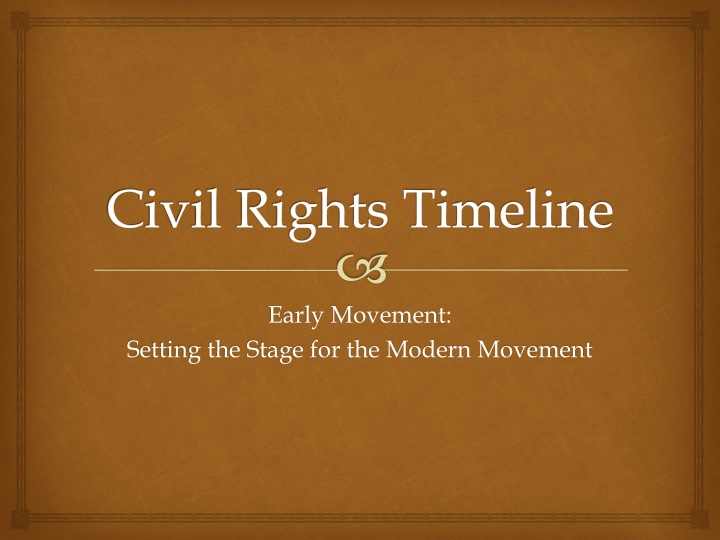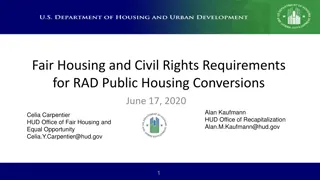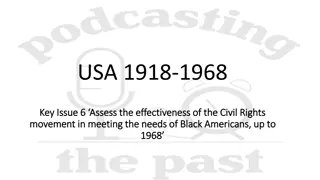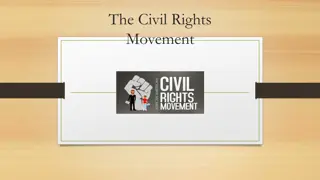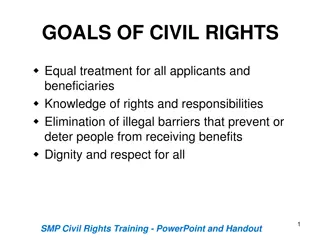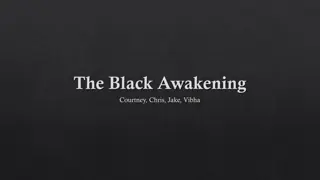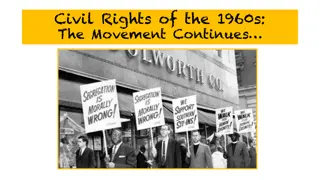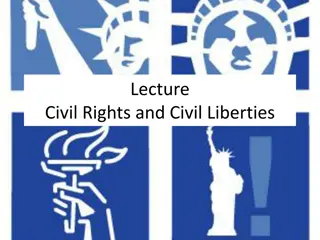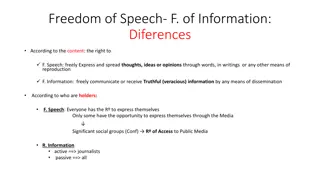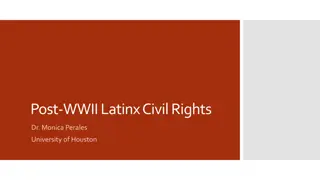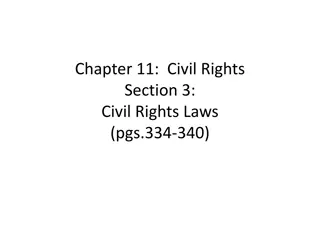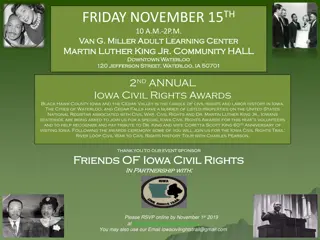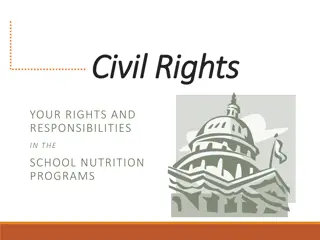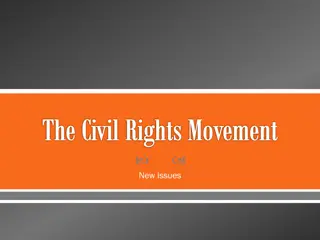Early Civil Rights Movement: Abolition, Legislation, and Freedom
Abolitionist groups form to fight against slavery in 1775, leading to the establishment of the Pennsylvania Society for Promoting the Abolition of Slavery. Legislation such as the Slave Trade Act of 1794 and the outlawing of slavery by different states played a crucial role in the early civil rights movement. Acts like the Fugitive Slave Act of 1793 and the ban on the importation of slaves in 1807 further shaped the landscape of civil rights in the United States.
Download Presentation

Please find below an Image/Link to download the presentation.
The content on the website is provided AS IS for your information and personal use only. It may not be sold, licensed, or shared on other websites without obtaining consent from the author.If you encounter any issues during the download, it is possible that the publisher has removed the file from their server.
You are allowed to download the files provided on this website for personal or commercial use, subject to the condition that they are used lawfully. All files are the property of their respective owners.
The content on the website is provided AS IS for your information and personal use only. It may not be sold, licensed, or shared on other websites without obtaining consent from the author.
E N D
Presentation Transcript
Civil Rights Timeline Early Movement: Setting the Stage for the Modern Movement
Abolitionist Groups Form 1775 Founding of the Pennsylvania Society for Promoting the Abolition of Slavery (PAS), the world's first antislavery society and the first Quaker anti-slavery society. Benjamin Franklin becomes Honorary President of the Society in 1787. Thomas Paine speaks out against slavery and joins the PAS with Benjamin Rush.
Slave Trade Act of 1794 Passed by the United States Congress that limited American involvement in the trade of human cargo. This was the first of several acts of Congress that eventually stopped the importation of slaves to the United States. The bill was introduced during the 3rd Congress that convened December 2, 1793. This bill was then passed March 22, 1794, with the title: An Act to prohibit the carrying on the Slave Trade from the United States to any foreign place or country. In August 1795, Providence, Rhode Island merchant John Brown conspired to trade in slaves. In 1796 Brown s ship traveled to Havana, Cuba with 229 slaves. This trading voyage led to a trial of Brown in 1796 for violating the statute. Brown became the first American tried in federal court under the Slave Trade Act of 1794.Then on October 5, 1797, Brown lost his case and was forced to forfeit the ship in accordance with the law.
States begin to outlaw slavery Significant dates VT PA MA NH CT RI NY NJ European settlement 1666 1638 1620 1623 1633 1636 1624 1620 First record of slavery c.1760? 1639 1629? 1645 1639 1652 1626 1627 Official end of slavery 1777 1780 1783 1783 1784 1784 1799 1804 Actual end of slavery 1777 c.1845 1783 c.1845? 1848 1842 1827 1865
Fugitive Slave Act 1793 Mandated the return of any slave runaways. However, at that time, several Northern states began requiring a trial prior to the return of any alleged fugitive slaves. Ultimately, many of the Northern states did not necessarily comply with this act, as they were creating laws to ensure the personal liberties of all citizens, in an effort to prevent any free blacks from being kidnapped and inadvertently sent into slavery in the South. During these mandated trials, Northern juries were unlikely to rule in favor of the Fugitive Slave Act, instead protecting any slaves that had escaped to freedom.
Importation of slaves banned A senator from Vermont first introduced a bill to ban the importation of slaves in late 1805, and President Thomas Jefferson recommended the same course of action in his annual address to Congress a year later, in December 1806. The law was finally passed by both houses of Congress on March 2, 1807, and Jefferson signed it into law on March 3, 1807. However, given the restriction imposed by Article I, Section 9 of the Constitution, the law would only become effective on January 1, 1808. The law carried a fine of $800 for knowingly buying an illegally imported slave to $20,000 for equipping a slave ship. The law was poorly enforced and often violated.
Abolitionist Movement In 1831 William Lloyd Garrison of Boston begins publishing The Liberator, the most famous anti-slavery newspaper.
Slave Rebellion 1831 -- Nat Turner leads slave rebellion in Virginia; 57 whites killed; U.S. troops kill 100 slaves; Turner caught, tried and hanged.
Female Abolitionists Each year the American Anti-Slavery Society distributed an almanac containing poems, drawings, essays, and other abolitionist material. This issue was compiled by Lydia Maria Child (1802-1880), a popular writer recruited to the abolitionist cause by William Lloyd Garrison. In 1833, Mrs. Child produced An Appeal in Favor of that Class of Americans Called Africans, a sensational anti- slavery publication that won converts to the movement. From 1841 to 1849, she edited the New York-based National Anti-Slavery Standard newspaper.
Oberlin College Oberlin College, founded in 1833 is the first U.S. college to adopt co- education, is first to refuse to ban black students.
Fugitive Slave Act On September 18, 1850, the United States passed the Fugitive Slave Act (also known as the Compromise of 1850 and the Fugitive Slave Law). Highly controversial for its time, the Fugitive Slave Act declared that any runaway slaves that had escaped their masters and were living free in the North should be returned at once to their masters.
Aint I a Woman? Sojourner Truth connected with the abolitionist movement, becoming a popular speaker. In 1850, she also began speaking on woman suffrage. Her most famous speech, Ain't I a Woman?, was given in 1851 at a women's rights convention in Ohio.
Underground Railroad Harriet Tubman- A worker on the Underground Railroad, Tubman made 13 trips to the South, helping to free over 70 people. Created in the early 19th century, the Underground Railroad was at its height between 1850 and 1860
Uncle Toms Cabin 1852 March 20 Uncle Tom's Cabin by Harriet Beecher Stowe is published.
Dred Scott Supreme Court Decision 1857 -- Dred Scott Supreme Court decision rules that slaves do not become free when taken into a free state, that Congress cannot bar slavery from a territory, and that blacks cannot become citizens.
Civil War Begins 1861 -- Confederate States of America formed. Civil War begins.
Emancipation Proclamation 1863 -- President Lincoln issues Emancipation Proclamation freeing "all slaves in areas still in rebellion."
1865 Civil War ends on April 9th. In December the 13th Amendment, abolishing slavery, added to the Constitution.
Ku Klux Klan Forms The first Klan was founded in 1865 in Pulaski, Tennessee, as a terrorist organizationby veterans of the Confederate Army.They named it after the Greek word kuklos , which means circle. The name means "Circle of Brothers. Nathan Bedford Forrest is the first Grand Wizard. Although there was no organizational structure above the local level, similar groups arose across the South, adopting the name and methods.Klan groups spread throughout the South as an insurgent movement during the Reconstruction era in the United States.
Civil Rights Act of 1866 April 9 The Civil Rights Act of 1866 is passed by Congress over Johnson's presidential veto. All persons born in the United States are now citizens.
1868 14th Amendment conferring citizenship added to Constitution.
1868 Elizabeth Hobbs Keckley, a former slave turned successful seamstress who is most notably known as being Mary Todd Lincoln's personal modiste and confidante, publishes her autobiography, Behind the Scenes Or, Thirty Years a Slave and Four Years in the White House.
1870 15th Amendment barring racial discrimination in voting added to Constitution.
Civil Rights Act of 1871 Introduced as an anti-Klan bill, intended to enforce both the Fourteenth Amendment and the Civil Rights Act of 1866. Under the Klan Act during Reconstruction, federal troops were used rather than state militias to enforce the law, and Klansmen were prosecuted in federal court, where juries were often predominantly black. Hundreds of Klan members were fined or imprisoned, and habeas corpus was suspended in nine counties in South Carolina. These efforts were so successful that the Klan was destroyed in South Carolina and decimated throughout the rest of the former Confederacy, where it had already been in decline for several years. The Klan was not to exist again until its recreation in 1915, but it had already achieved many of its goals in the South, such as denying voting rights to Southern blacks
1875 Congress passes civil rights act granted equal rights in public accommodations and jury duty.
1883 Supreme Court invalidates 1875 Civil Rights Act, saying that the federal government cannot bar discrimination by corporations or individuals.
1884 Judy W. Reed, of Washington, D.C., and Sarah E. Goode, of Chicago, are the first African-American women inventors to receive patents. Signed with an "X", Reed's patent no. 305,474, granted September 23, 1884, is for a dough kneader and roller. Goode's patent for a cabinet bed, patent no. 322,177, is issued on July 14, 1885. Goode, the owner of a Chicago furniture store, invented a folding bed that could be formed into a desk when not in use.
Ida B. Wells In 1884 sues the Chesapeake, Ohio & South Western Railroad Company for its use of segregated "Jim Crow" cars.
Plessy vs. Ferguson 1896 -- Supreme Court approves "separate but equal" segregation doctrine.
1892 Ida B. Wells publishes her pamphlet Southern Horrors: Lynch Law in All Its Phases.
1905 July 11 First meeting of the Niagara Movement, an interracial group to work for civil rights.
Alpha Kappa Alpha 1908 Alpha Kappa Alpha At Howard University, African-American college women found the first college sorority for African-American women.
NAACP Forms 1909 February 12 Planned first meeting of group which would become the National Association for the Advancement of Colored People (NAACP), an interracial group devoted to civil rights. The meeting actually occurs on May 31, but February 12 is normally cited as the NAACP's founding date. May 31 The National Negro Committee meets and is formed; it will be the precursor to the NAACP. 1910 May 30 The National Negro Committee chooses "National Association for the Advancement of Colored People" as its organization name.
Resegregation of Federal Workplaces 1914 Newly elected president Woodrow Wilson orders physical re-segregation of federal workplaces and employment after nearly 50 years of integrated facilities
1916 The Great Migration begins and lasts until 1940. Approximately one and a half million African- Americans move from the Southern United States to the North and Midwest. More than five million migrate in the Second Great Migration from 1940 1970, which includes more destinations in California and the West.
Race Riots 1919 summer Red Summer of 1919 riots: Chicago, Washington, D.C.; Knoxville, Indianapolis, and elsewhere. September 28 Omaha Race Riot of 1919, Nebraska. October 1 5 Elaine Race Riot, Phillips County, Arkansas. Numerous blacks are convicted by an all-white jury or plead guilty. In Moore v. Dempsey (1923), the Supreme Court overturns six convictions for denial of due process under the Fourteenth Amendment. 1921 May 31 Tulsa Race Riot, Oklahoma
Organizing Agencies 1925 American Negro Labor Congress founded. Brotherhood of Sleeping Car Porters organized. The Harlem Renaissance is named after the anthology The New Negro, edited by Alain Locke (also known as the New Negro Movement). 1929 The League of United Latin American Citizens, the first organization to fight for the civil rights of Hispanic Americans, is founded in Corpus Christi, Texas. 1930 The League of Struggle for Negro Rights is founded in New York City. Jessie Daniel Ames forms the Association of Southern Women for the Prevention of Lynching. She gets 40,000 white women to sign a pledge against lynching and for change in the South
Scottsboro Boys Trail 1931 March 25 Scottsboro Boys arrested. All are later freed, pardoned or paroled. The film Heavens Fall was made about the incident
1937 Zora Neale Hurston authors the novel Their Eyes Were Watching God
1939 Easter Sunday Marian Anderson performs on the steps of the Lincoln Memorial in Washington, D.C. at the instigation of Secretary of Interior Harold Ickes after the Daughters of the American Revolution (DAR) refused permission for Anderson to sing to an integrated audience in Constitution Hall and the federally controlled District of Columbia Board of Education declined a request to use the auditorium of a white public high school.
Strange Fruit Billie Holiday first performs "Strange Fruit" in New York City. The song, a protest against lynching written by Abel Meeropol under the pen name Lewis Allan, became a signature song for Holiday. http://www.youtube.com/watch?v=isU_OjY94NY
1939 Protests August 21 Five African-American men recruited and trained by African-American attorney Samuel Wilbert Tucker conduct a sit-in at the then-segregated Alexandria, Virginia, library and are arrested after being refused library cards. September 21 Followers of Father Divine and the International Peace Mission Movement join with workers to protest racially unfair hiring practices by conducting "a kind of customers' nickel sit down strike" in a restaurant.
1940 Hattie McDaniel becomes the first African- American to win an Academy Award. She wins Best Supporting Actress for her performance as Mammy in Gone with the Wind.
Legal Defense Fund NAACP Legal Defense and Educational Fund is formed in 1940.
March on Washington Planned 1941 January 25 A. Philip Randolph proposes a March on Washington, effectively beginning the March on Washington Movement.
Congress on Racial Equality Forms 1942 Six non-violence activists in the Fellowship of Reconciliation Bernice Fisher, James Russell Robinson, George Houser, James Farmer, Jr., Joe Guinn and Homer Jack found the Committee on Racial Equality, which becomes Congress of Racial Equality
1944 April 3 In Smith vs. Allwright, the Supreme Court rules that the whites-only Democratic Party primary in Texas was unconstitutional. April 25 The United Negro College Fund is incorporated. July 17 Port Chicago disaster, which led to the Port Chicago mutiny. August 1 7 - Philadelphia transit strike of 1944 - a strike by white transit workers protesting against job advancement by black workers is broken by the U.S. military under the provisions of the Smith-Connally Act November 7 Adam Clayton Powell, Jr. is elected to the U.S. House of Representatives from Harlem, New York. Miami hires its first black police officers.
1946 June 3 In Morgan v. Virginia, the US Supreme Court invalidates provisions of the Virginia Code which require the separation of white and colored passengers where applied to interstate bus transport. The state law is unconstitutional insofar as it is burdening interstate commerce an area of federal jurisdiction. Irene Morgan ,27-year-old Baltimore-born African-American was arrested and jailed in Virginia for refusing to give up her seat on an interstate Greyhound bus to a white person.
CORE April 9 The Congress of Racial Equality (CORE) sends 16 men on the Journey of Reconciliation. The two-week journey by 16 men began on 9 April 1947. It was seen as inspiring the later Freedom Rides of the 1960s Civil Rights Movement. James Peck, one of the white participants, also took part in the Freedom Ride of May 1961.
